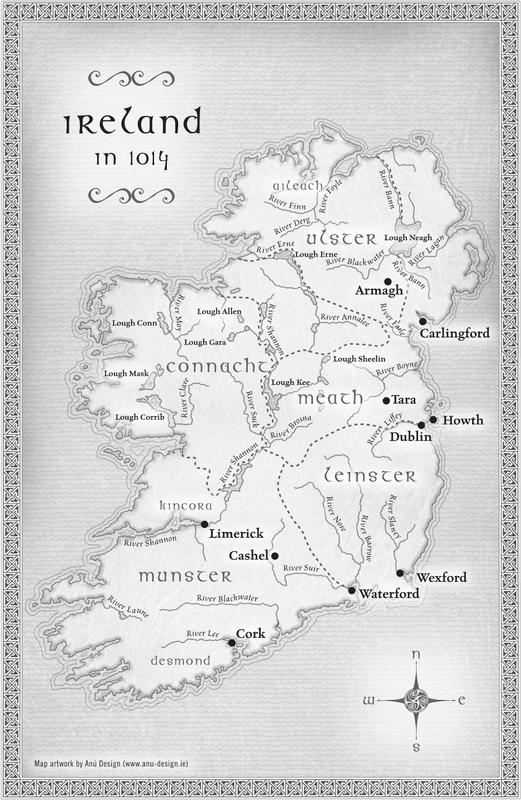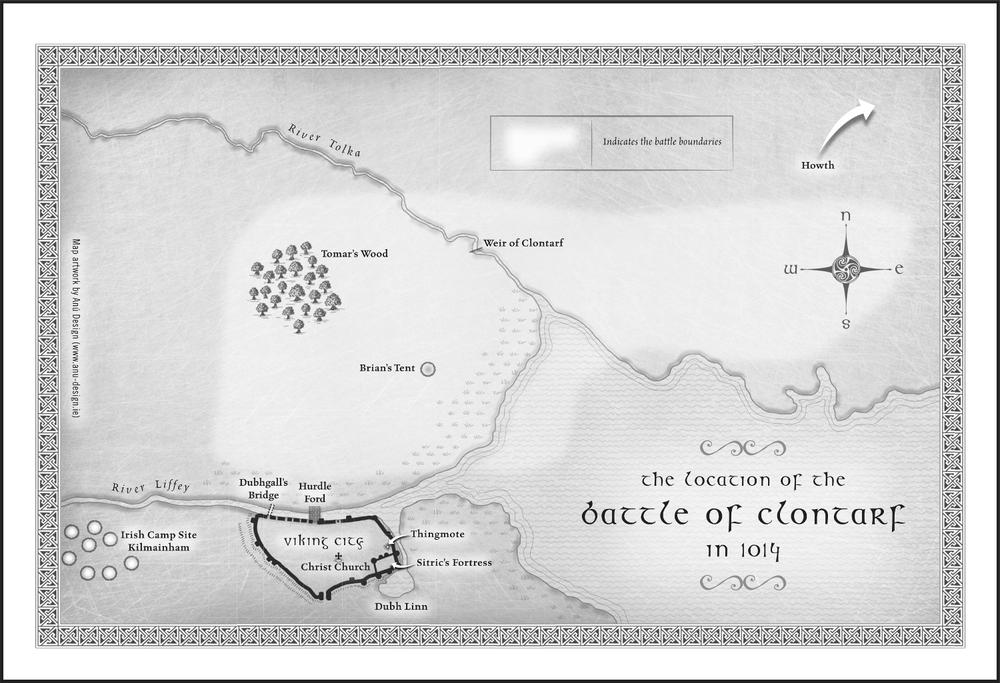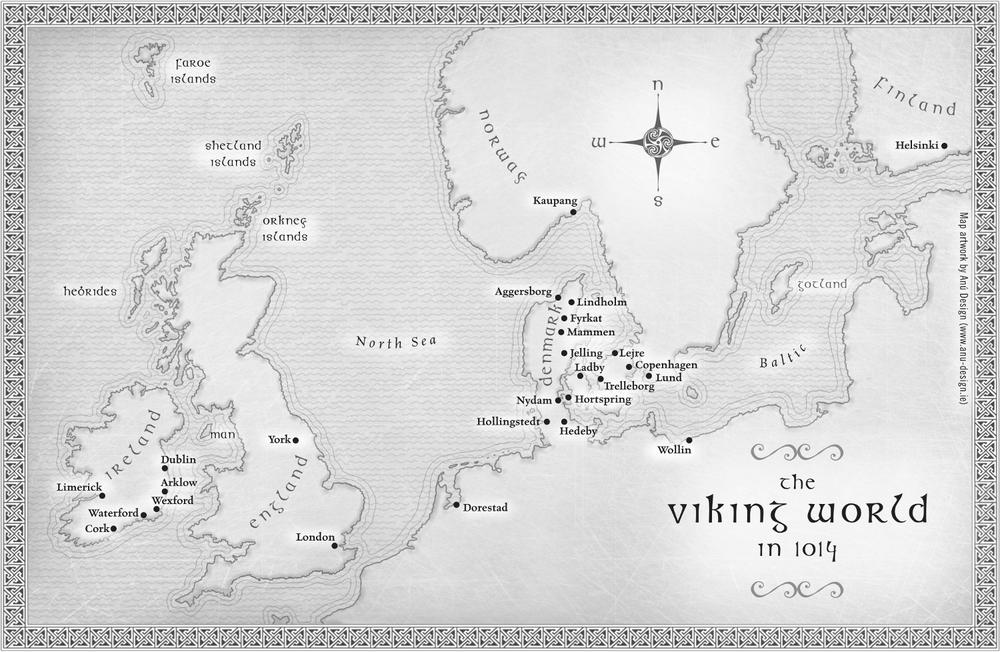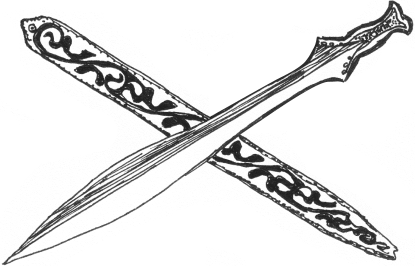1014: Brian Boru & the Battle for Ireland (2 page)
Read 1014: Brian Boru & the Battle for Ireland Online
Authors: Morgan Llywelyn




B
attle morning! A warrior spirit thrills to those words. This day might see the greatest battle of all, the one which a man will remember for the rest of his life. He can tell the story over and over again to his grandchildren and warm his cold bones by the fire of their admiration. He may even become a legend.
Battle morning!
Few had slept well the night before. Even the most experienced campaigners were restless, as men are
restless
when there is a storm gathering and the air is heavy with foreboding. New recruits had listened eagerly to the talk of the veterans, trying to grasp clues as to the future. But around the campfires the seasoned fighters had talked about the food or the weather or the long march they had just endured. Hardly any spoke of their women at home and none mentioned their children. The impending battle was not discussed by men who knew they had little control over its outcome. Awake before first light, they lay on their backs and stared at the sky,
waiting for the stars to fade. Wondering who would be alive to observe the next appearance of the stars.
Advance scouts had been reporting to the command camp all night. The tall old man who had not slept
listened
to them with folded arms, assessing the
information
they brought. Sometimes he nodded. Sometimes he merely raised his head and turned a serious face towards the east, visualising. He carried it all in his head as he had carried everything in his head for so many years – the dreams, the plans, the strategies. All in one head, which was too valuable to risk in battle now, according to his sons.
His eyes burned with exhaustion. He passed one hand over them, a huge, still-powerful hand – had it not killed an opponent in single combat just the year before? He would defer to his sons’ wishes because it was time to let the burden of responsibility pass to them, but he would keep his sword by his side.
Tomorrow, when the victory was won, he could sleep.
The April sky turned a translucent green with the coming of the dawn. The date was Good Friday, 23 April in the Year of Our Lord 1014. The most ferocious battle ever fought in Ireland was about to begin.
I
n 1014 Ireland did not think of itself as a nation or as a political entity. The concept of ‘nationhood’ was unknown. Poets referred to the land of many tribes as Erin, after an ancient goddess named Eriu. The
inhabitants
called themselves the Gael, or the Scoti. On maps drawn by the geographers of antiquity the island west of Britain was called Hibernia, from the Latin word
hibernus
, meaning ‘wintry’.
The Gael of Ireland belonged to one of several branches descended from a passionate and energetic warrior race whom the early Greeks identified as the Keltoi, or Celts. As with most things concerning the Celts, there is controversy about their origins, even about their right to be called a race. The Celtic
homeland
is described as extending from Bohemia in
Germany
to Silesia in southwestern Poland. The
majority
of modern anthropologists trace the Celts through their linguistic ties back to the Indo-Europeans, people of the steppes north of the Black Sea who migrated throughout continental Europe before the third
millennium
BC and became one of the foundations of western civilisation.
Archaeological studies indicate that the Gael reached Ireland by sea around the end of the Bronze Age. They brought iron weapons with them, enabling them to supplant the Bronze Age inhabitants who, in turn, had replaced Neolithic Man. At first the settlers probably intermarried with the surviving natives. There were no more incomers. For over a thousand years the Gael held undisputed sway over the land of Ireland. Great courage, a love of beauty, and a reverence for the natural world were amongst the qualities they admired and pursued. This was the culture that eventually produced the Book of Kells, the Tara Brooch, thousands of other works of art, and the Brehon law, which was described in 1987 by the Rt Honourable John J Flaherty, Chief Justice of Pennsylvania as ‘the most humane and realistic legal system ever devised’. But more of that later.
From their point of view, the Gael had found paradise
at the edge of the Atlantic. Their island, which is about the size of the American state of Maine, was rich in the natural resources needed to support a pastoral,
semi-nomadic
lifestyle. The movement of glaciers during the Ice Age had carved the island into a fertile
central
plain ringed by coastal highlands. Although in the same latitude as Labrador, Ireland benefited from mild southwesterly winds and the warm waters of the Gulf Stream, which created a temperate climate. The island as a whole was a near-wilderness of timeless beauty. Much of the land was covered by expanses of mixed forest, primarily oak, but also hazel, ash, rowan, holly and yew. Thus there was an endless supply of timber to build shelter and to fuel fires. Field and forest abounded with game, rivers and lakes swarmed with fish, and the coasts provided a wide variety of shellfish. There also were deposits of gold, silver and copper to create the spectacular personal ornaments beloved of the Gael.
With everything they needed provided by the island on which they lived, the Gael had little inclination to venture further afield. A few did turn to piracy,
harrying
British sea lanes and occasionally seizing slaves; Saint Patrick was first brought to Ireland as a slave. For the most part, the Gael lived much as their warrior forebears had done on the European continent. Surrounded by
water on all sides, Ireland was isolated for many
centuries
. The male population had no one to hone their battle skills upon but one another. This they did, with gusto. The tribes fought each other until battle became both sport and art, a way of life by which they defined themselves.
During the first millennium after Christ, Ireland contained between 100 and 150 semi-autonomous petty kingdoms, each made up of several tribes. Every tribe had its own chieftain; every kingdom had its own king who was elected from amongst the suitable
members
of the most powerful tribe. These petty kings had the right to demand tribute, a form of tax which
usually
consisted of cattle and warriors, from the tribes in their territory. They raised armies to fight other kings for territorial conquest, for the enforcement of
hegemony
, or to plunder and weaken a rival kingdom. The size and prosperity of the individual kingdoms waxed and waned with the fortunes of war. The victors were immortalised by the poets.
To add to the divisiveness, the island consisted of five separate and semi-autonomous provinces: Ulster (Uladh in Irish) in the north; Leinster (Laighin) in the east; Connacht (Connachta) in the west; Munster (Mumhan) in the south; and in the centre, Meath (Mídhe), the
royal province. These were ruled by provincial kings to whom the petty kings in their territory owed tribute. The provincial kings, in turn, owed tribute to an
overlord
known as the Árd Rí, or high king, whose
traditional
seat was at Tara in Meath. Tara today is a long grassy ridge often occupied by grazing sheep. From its elevation on a clear day one can see mountains in each of the other four provinces, a kingly view indeed.
In no stage of Irish history had the term ‘high king’ implied monarchy. No high king governed all of
Ireland
. The Árd Rí reigned but did not rule. His subjects were the provincial kings who owed him tribute and courted his patronage to support their individual power. This arrangement likewise controlled the
downward
dispersion of property through petty kings and clan chieftains. Below the nobles were the freemen, and on the lowest rung of the ladder, the slaves, most of whom were captives taken in war. Slavery was not a permanent condition. A slave could buy his or her
freedom
, and many did.
The office of king, of whatever rank, was elective. In the case of the provincial kings and the high king it was restricted to the princely class, which included anyone whose great-grandfather had been a king. Male
members
of this class were obliged to undergo a very specific
training, both mental and physical. The eldest son of a king did not automatically inherit his father’s role. So long as there was an eligible member of his family who had the support of the other tribes, that person might accede to the kingship if he was of the age, strength, and character to suit the office. Thus the method of
choosing
a king was not fully one of merit, nor fully elective, nor fully hereditary, but a combination of all three. In the case of the Árd Rí, the family from which he came was of paramount importance. For centuries the high king was elected from either the northern or southern branches of the Uí Néill, the family with the longest history of high kingship.
Until one man changed that.
The Gael developed a highly stratified society
conforming
to an elaborate system known as Brehon law. Brehons were judges, members of the intellectual class that included teachers, healers, and bards. Bards were highly revered – a poet was considered the equal of a prince, a gifted satirist could topple a king. Brehons, as interpreters of the law, were concerned with every aspect of tribal life, from governing the election of kings to writing statutes concerning beekeeping.
Under Brehon law women had a degree of equality with men. Whether single or married they could
inherit property and conduct its usage. The importance of women’s work was shown by the value assigned to their implements: a needle used in embroidery was valued at an ounce of silver, or part ownership of a yearling heifer. In case of divorce, which was common in early Ireland, a woman’s dowry might be returned to her. Polygamy was accepted if all parties consented, although in certain circumstances, such as incest,
adultery
was punishable by death. There was no such thing as illegitimacy: any act which resulted in a child was considered a marriage. There were no orphans. If a child’s parents were dead, he or she was fostered by other members of the tribe.
Because the pre-Christian Gael had no written
language
, their history was painstakingly memorised by their bards over a period as long as twenty years. Poetry in its primitive form was a chant of pure emotion, speaking directly to the spirit. Captured in poetry like a fly in amber, Ireland’s history and genealogies were transmitted from one generation to the next virtually intact.
In the sixth century, Christianity arrived in Ireland together with its concomitant literacy. The new faith was superimposed on the ancient druidic tradition without a substantial struggle. Ireland underwent an
almost bloodless conversion as kings and princes
gradually
accepted fresh ideas. The majority of the Gael, who had a long history of loyalty to their chosen leaders, followed them into the worship of Christ. Canon law took its place beside Brehon law in Gaelic society. For a long time observance appears to have been optional, however.
The people remained pastoral. The only towns of any size were those which developed around monastic centres. Tribal warfare continued unabated; cattle raids were as frequent as ever. Bands of outlaws, even if avowed Christians, were not above looting a
monastery
.
Literacy offered a fresh outlet for the artistic impulse. Masterpieces like the Book of Kells testify to a new faith and a soaring imagination. Christian craftsmen turned native gold and silver into objects of
breathtaking
beauty, such as the Ardagh Chalice. The Ireland of saints and scholars existed for several generations – but it could not last.
If the Gael were content to stay at home, others were not. The last decade of the eighth century saw the arrival of the Vikings. Their power in Ireland would reach its zenith with the Battle of Clontarf.
‘Viking’ was an appellation applied impartially to sea rovers from Norway and Denmark, as well as to
adventurers
from Sweden, Jutland, Iceland, and the islands and coasts of the Baltic. These people did not actually call themselves Vikings until the twelfth century, however. The origin of the word
viking
is something of a mystery. It may have been a verb describing what the
Scandinavians
did during three centuries of their history: they were seagoing marauders, they were Northmen who went ‘viking’.
Another term applied to them was ‘Land Leaper’, meaning someone who seizes another’s land. During the cold, dark, interminable nights of winter in
northern
Europe, a man could only dream of the sun – of green grass, of golden fields of grain. Dream … and long … and ultimately determine to find. And seize for
himself
. This very human urge motivated one of the most violent eras in history, but it was not the only cause.
A rise in the population of Scandinavia, which began in the seventh century, reached a climax in the tenth, putting great pressure on land and resources. Added to this was the resentment of the Norse
jarls
, or noblemen, with their own independent earldoms, at efforts being made to unify Norway under one crown.
The result of these forces coming together was an explosion of Vikings onto the world stage.
As with most of early history, facts about this period
have been exaggerated and embellished until the underlying kernel of truth may be hard to find. A
predilection
for embroidering history is not unique to the Irish. Down through the ages famous historians have refused to let the truth get in the way of a colourful story. Plato, Herodotus, Giraldus Cambrensis – and that master propagandist, Julius Caesar – all employed
creative
fiction to suit their purposes. Thus it is not
surprising
that something as momentous in its time as the Battle of Clontarf has been heavily mythologised. The protagonists were always prime candidates for myth – none more so than the Vikings.
During the ninth and tenth centuries the political situation in Ireland had changed dramatically. Adding Vikings to the mix destabilised a complex societal
structure
built on blood and hereditary ties, an archaic code of law, and shifting military alliances. It also seemed to herald an increase in violence among the native Irish, who could not fail to be affected by the actions of the invaders.



